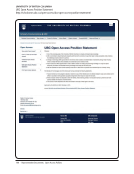SPEC Kit 343: Library Support for Faculty/Researcher Publishing · 123
UNIVERSITY OF WISCONSIN-MADISON
FAQ—MINDS@UW
http://uwdcc.library.wisc.edu/minds/faq.shtml
FAQ — MINDS@UW
http://uwdcc.library.wisc.edu/minds/faq.shtml[9/17/14 2:16:55 PM]
top of page
top of page
1. Does a Google search find content in MINDS@UW?
Yes. Google indexes MINDS@UW regularly, and MINDS@UW contents
are included in Google Scholar as well.
2. Who can view content located in MINDS@UW?
MINDS@UW is an open archive and its contents are therefore accessible
free of charge to anyone on the World Wide Web. While it may be
possible possible to restrict access to parts of MINDS@UW, we do not
encourage it. The goal of MINDS@UW is to allow any person with an
Internet connection and web browser to view its contents.
3. Is MINDS@UW full-text searchable?
For most items, yes. Exceptions would include scanned pages that do not
undergo optical character recognition (OCR).
4. How do I search across a lot of sites like MINDS@UW?
You could use Google or Google Scholar, but your results would be
mixed with non-academic sources.
Try OAIster instead. It crawls MINDS@UW and hundreds of repositories
like it. Also consider the Registry of Open Access Repositories search
page, the National Science Digital Library, and for open access journal
content, the Directory of Open Access Journals.
If you’re interested in open access within a particular discipline, ask the
MINDS@UW coordinator what resources are available.
MINDS@UW Organization
1. What is the difference between a community and a collection?
A community is a group of people, such as a campus, department, or
research unit. Communities may contain sub-communities and collections.
A collection is a group of content items. Decisions about deposit rights
and workflows happen on this level.
2. What do I need to know to create a community in MINDS@UW? Can I
get training somewhere?
The MINDS@UW coordinator can provide initial training (as well as
consultation later on) in getting your community off the ground. This
instruction will help your community to establish its workflow and to learn
about the MINDS@UW interface. The process of putting items into
MINDS@UW is relatively intuitive and does not require knowledge of any
specialized software.
3. Can I change my community or collection’s name, logo, or description
after it’s created?
Certainly! Just ask via the MINDS@UW feedback form.
About MINDS@UW
1. Why did the UW Libraries decide to start MINDS@UW?
MINDS@UW was created to collect and disseminate scholarly material
created at the University of Wisconsin. It was envisioned as a means to
preserve scholarly output and disseminate material not supported by
UNIVERSITY OF WISCONSIN-MADISON
FAQ—MINDS@UW
http://uwdcc.library.wisc.edu/minds/faq.shtml
FAQ — MINDS@UW
http://uwdcc.library.wisc.edu/minds/faq.shtml[9/17/14 2:16:55 PM]
top of page
top of page
1. Does a Google search find content in MINDS@UW?
Yes. Google indexes MINDS@UW regularly, and MINDS@UW contents
are included in Google Scholar as well.
2. Who can view content located in MINDS@UW?
MINDS@UW is an open archive and its contents are therefore accessible
free of charge to anyone on the World Wide Web. While it may be
possible possible to restrict access to parts of MINDS@UW, we do not
encourage it. The goal of MINDS@UW is to allow any person with an
Internet connection and web browser to view its contents.
3. Is MINDS@UW full-text searchable?
For most items, yes. Exceptions would include scanned pages that do not
undergo optical character recognition (OCR).
4. How do I search across a lot of sites like MINDS@UW?
You could use Google or Google Scholar, but your results would be
mixed with non-academic sources.
Try OAIster instead. It crawls MINDS@UW and hundreds of repositories
like it. Also consider the Registry of Open Access Repositories search
page, the National Science Digital Library, and for open access journal
content, the Directory of Open Access Journals.
If you’re interested in open access within a particular discipline, ask the
MINDS@UW coordinator what resources are available.
MINDS@UW Organization
1. What is the difference between a community and a collection?
A community is a group of people, such as a campus, department, or
research unit. Communities may contain sub-communities and collections.
A collection is a group of content items. Decisions about deposit rights
and workflows happen on this level.
2. What do I need to know to create a community in MINDS@UW? Can I
get training somewhere?
The MINDS@UW coordinator can provide initial training (as well as
consultation later on) in getting your community off the ground. This
instruction will help your community to establish its workflow and to learn
about the MINDS@UW interface. The process of putting items into
MINDS@UW is relatively intuitive and does not require knowledge of any
specialized software.
3. Can I change my community or collection’s name, logo, or description
after it’s created?
Certainly! Just ask via the MINDS@UW feedback form.
About MINDS@UW
1. Why did the UW Libraries decide to start MINDS@UW?
MINDS@UW was created to collect and disseminate scholarly material
created at the University of Wisconsin. It was envisioned as a means to
preserve scholarly output and disseminate material not supported by






































































































































































